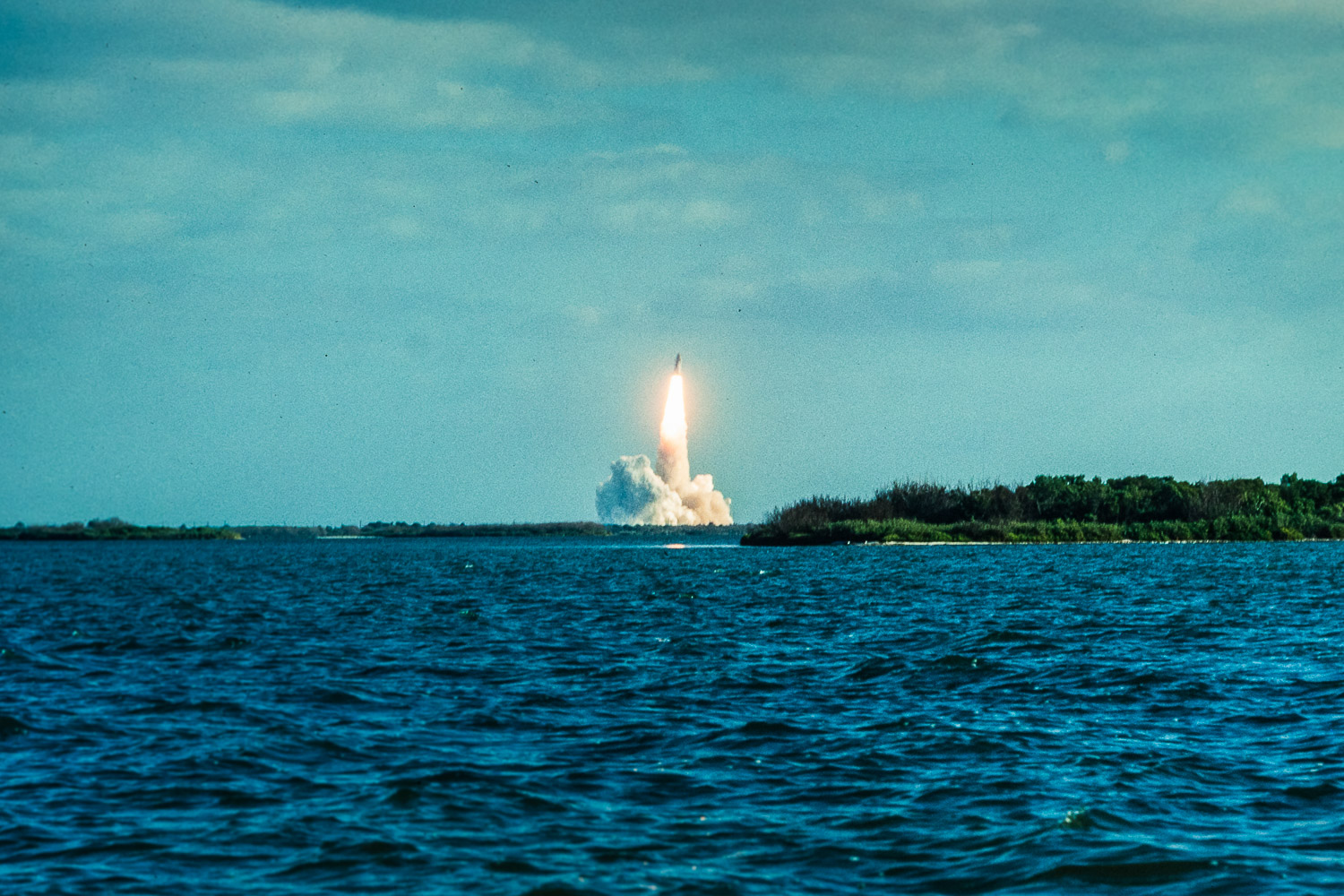Back to Alaska: Again, again and again!
There’s a land where the mountains are nameless,
And the rivers all run God knows where;
There are lives that are erring and aimless,
And deaths that just hang by a hair;
There are hardships that nobody reckons;
There are valleys unpeopled and still;
There’s a land—oh, it beckons and beckons,
And I want to go back—and I will.
I was a 15 year old in England when my geography teacher read this Robert Service poem by way of introduction to a lesson on the Yukon and Alaska.
I never forgot it: and it inspired me to one day make the trek to the North and see this land for myself. I did. Four times. Three times by road, including my first trip in 1977 along the entire Alaska Highway and back when the road was barely much more than a gravel track – an adventure the likes I’ve never experienced since.

Twice more, and nearly 20 years after that first trip, I drove my family up in a VW camper, and more recently took a cruise from Vancouver to Glacier Bay.
These trips have taught me the one thing you need more than another on this journey – prayers! Thats what you need if you are heading up there. Prayers, along with time. Lots of it.
Pray for good weather. The weather is so mercurial. But to see Mount McKinley at its magnificent best, you need a clear day.

The same for Glacier Bay. For The Inside Passage. For the Alaskan fjords.
That first trip in 1977 was organized more than a year earlier before I set out on my world adventure from England. My cousin and her husband, Pam and Tim Greenish, arrived from the UK having shipped a specially converted Land Rover to North America. It looked like a cross between a tank and a combat camper.
We met up in Banff, Alberta.
Along with their two small children, the family slept in the van and I attached a tent to the back door – largely for safety from marauding bears – and slept in that as we made our way up the 1500 mile long Alaska Highway.
It was an unbelievable journey through Northern British Columbia and the Yukon. In those days it was little more than a twisty, dusty, gravel road, steeply graded which meant on more than one occasion we were in danger of rolling off the highway unless we hit a fast enough speed on the steep corners.
The hardships: rough pavement, dust, mud, and long empty stretches between the few settlements supplying food and gas. And the mosquitoes. The giant Alaskan mosquitoes – 35 species. They were everywhere – and boy, did they bite. It was one of the perils of the trip.
The payoff? Beautiful landscapes, wildlife, and a feeling of absolute, total freedom. It was rigorous driving, and we barely did more than 125 miles a day – but along the way we saw spectacular scenery and amazing wildlife: moose, grizzly and black bears, elk and even wolves.
Construction of the Highway officially began in March 1942. Army engineers were ordered to construct a road that would proceed in a northwesterly direction from the railhead at Dawson Creek, BC, and connect with the existing highway at Delta Junction, Alaska. They punched a pioneer road through the wilderness in 8 months.
An overland link between Alaska and the Lower 48 had been studied as early as 1930 but with the bombing of Pearl Harbour in December 1941, it was deemed a military necessity.
One construction worker described the scene upon arriving in the North in March1942 like this: “We are now located on the last fringe of civilization. Open fires burn at night, and wild animals roam around 24 hours a day.”
Some sections of the Alaska Highway followed existing winter roads, summer pack trails and winter trap lines. Where no trails existed, reconnaissance parties scouted through river valleys and mountain passes, often struggling through waist-deep snow and climbing over “boulders as big as boxcars.”
The Alaska Highway opened to the public in 1948.
The scenery was an ever changing landscape – we drove along fjords, through mountain ranges and past glaciers and right into Mount McKinley National Park, where the weather was clear enough to see the mountain against perfect blue skies. What makes this mountain unique is that you can see the whole thing from its base to its summit, with very few small foothills blocking the view.
We stayed at a campground, Wonder Lake, just below the mountain, with grizzly bears all around us for company.
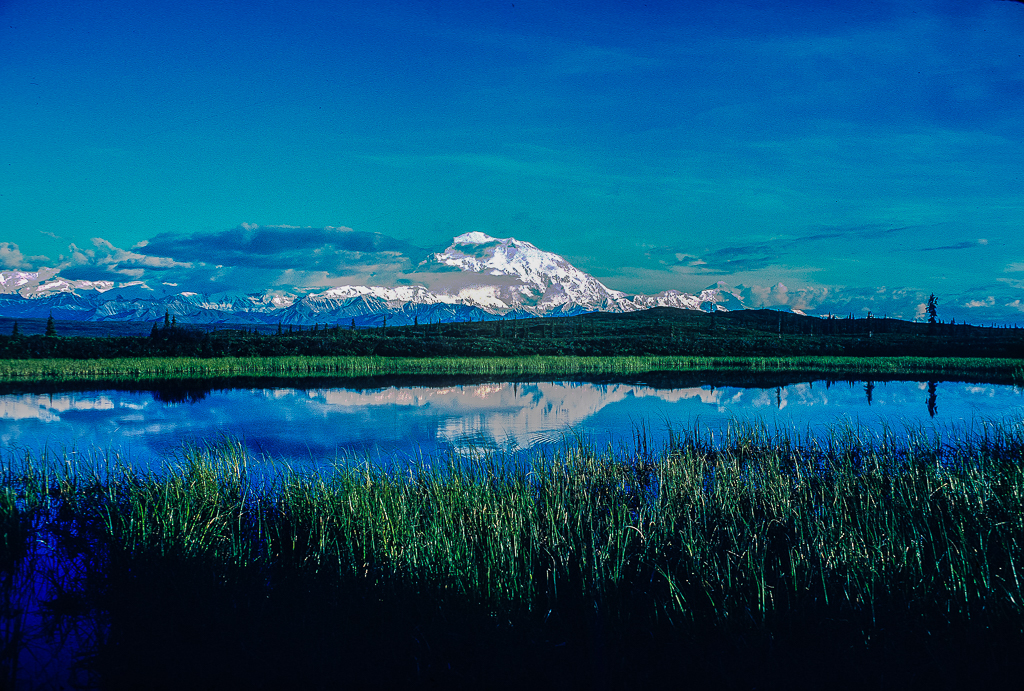

When arrived in Fairbanks I wore my journalist’s hat again and flew up to the Arctic Circle with BP to see their vast oil operations and wrote a feature for the London Daily Mail on the massive Alyeska oil pipeline which was just being completed. It snaked its way through the Arctic tundra from Prudhoe Bay to Valdez, Alaska, in what was described as a monumentally challenging construction project.

When we arrived in Haines, Alaska, for the journey back to Canada we had planned to take an Alaskan State ferry: but there was a long-running strike which grounded all ferries to a halt. While Pam and Tim could afford the time to wait it out, I had to get back through the US before my year-long visa ran out. So I hitched a ride, literally, on a floatplane at the local airport.
I stood on the small runway with my finger out and within minutes a perplexed pilot stopped, asked what I was doing and thought it was so cheeky that he agreed to fly me south.
We got on so well he even detoured over Glacier Bay (my prayers were answered there – the weather was perfect) which allowed for some spectacular photographs. You could even hear the ice calving over the sound of the plane’s engines.



He dropped me in Ketchikan, Alaska, where I put my thumb out again and caught a ride on a tug boat heading to Prince Rupert in return for a bottle of Scotch. It was rough accommodation, but I was given a space for my sleeping bag – not that I really slept as we were in the land of almost no darkness at night and we were sailing though the iconic Inside Passage – which thousands of tourists pay to see from the comfort of cruise ships.
I hitched from Prince Rupert 1,000 miles to Prince George and on to Vancouver. That left me just a few days to get down to LA and pick up my bags before heading off again. This time back to Vancouver, where I met my wife on the first day and married her a year later!
It wasn’t until 20 years later that Carol-Ann, our son, Simon, and I attempted the adventure again – for two summers running in the early 1990s. We did it two summers in a row as we all enjoyed the experience so much. The drive, the campgrounds, the camp food, wildlife and scenery. It was the perfect place to get away from the stresses and strains of work and school.
It was also rather different to my first trip – the Alaska Highway had been hugely upgraded. Almost a freeway in comparison to our journey in 1979. Many sections of the road were flattened, straightened and even covered by tarmac.
We spent time camping – our favourites included Muncho Lake in northern BC.The lake was a beautiful colour, the result of copper oxides leached from the bedrock. To get there we completed a hazardous drive through the Northern Rockies. The road was steep and narrow with no shoulder. Stone sheep would suddenly appear in the middle of the road as we rounded a curve. Rocks were still falling down the mountain.
Then there was Watson Lake in the Yukon Territory – home to the signposts. A homesick soldier put up an arrow with the name of his hometown that also stated the mileage. Other soldiers followed suit, and the tradition continues today.
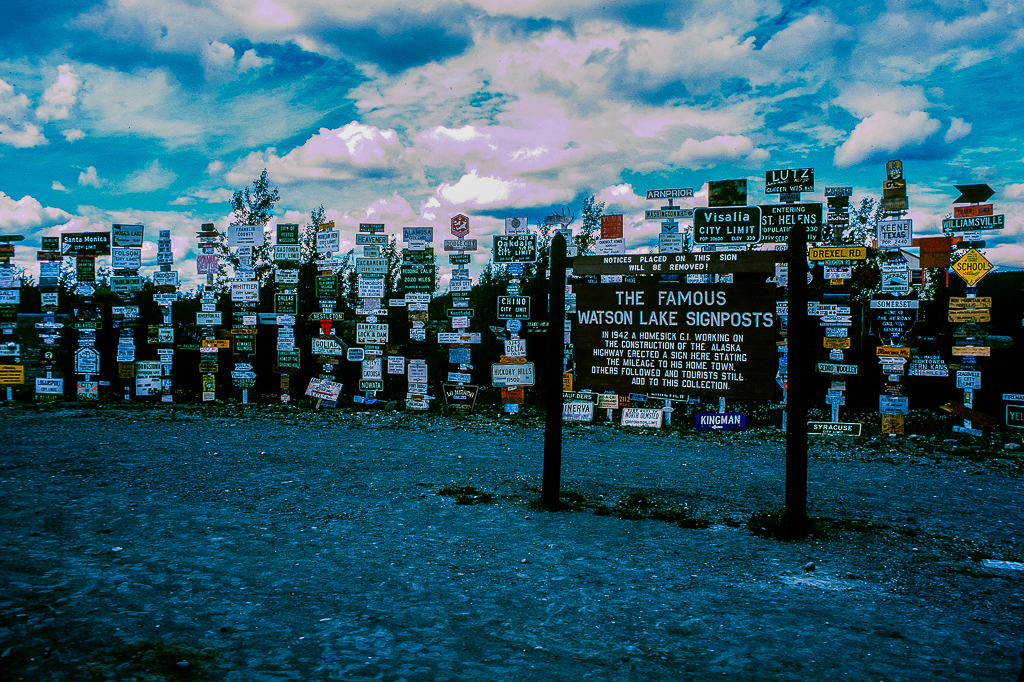
But it was probably Kluane Lake in the Yukon that stole the show during the family drive. Near the ghost town of Silver City, Kluane Lake is absolutely stunning. Forty-six miles long, it is the largest lake in Yukon Territory — and part of the largest protected area in the world. It is also a perfect place to watch the Northern Lights as they dance around the night sky.
All the time we drove, there were many RVs and trucks thundering along on the Alaska Highway: very different from that first trip when you could go all day and not see a vehicle.
We wanted to see as many Alaskan attractions as possible. And to explore Denali National Park, home to North America’s highest mountain, indigenous culture and the so-called “Denali Big Five” species – moose, caribou, grizzly bear, wolf and Dall sheep, we had to make a 13 hour round trip by school bus.
By this time cars weren’t allowed into the park, and school buses were brought in to take tourists on different trips throughout the park. By going all the way to Denali we had a better chance of seeing wildlife and I could re-live my previous camping experience at Wonder Lake.
On the way back, we detoured up the iconic 500-mile long Dempster Highway.
The Dempster Highway is North America’s most adventurous road trip. You see jagged peaks, caribou, cross the Arctic Circle, pass through tight-knit indigenous communities and see the mighty Mackenzie River.
Shortly after the Dempster Highway begins, fang-like peaks rear ups, piercing the bright blue horizon. This is epic Tombstone park.
The Dempster passes through a Canadian Serengeti – wild, wide-open country, teeming with frontier beasts. Travellers keep eyes peeled for grizzlies patrolling the mountain slopes, moose plodding through swamplands, and – at certain times of year – herds of caribou so dense they block the highway and darken the far horizon.
The road is rough, made of razor sharp shale. We were warned multiple times about the likelihood of punctures, and sure enough at just about the furthest point along the 500 mile long highway we lost a tire.
I had an additional spare – but not being very practical, not at all sure how to put it on! Those prayers came in handy again. A German tourist – one of few on the road that day – stopped, took pity on us and changed the tire in no time.
The Dempster adventure was a dramatic end to our Alaska road trip.
Until….the summer of 2019, the year before the pandemic. My wife and I were telling friends from the UK they should take advantage of the cheap Alaska cruise. They didn’t, but we did.
We took a seven day cruise on the Nieuw Amsterdam from Vancouver to Alaska – leaving on a a glorious sunny day.
And then, we needed those prayers again. The next morning we couldn’t see a thing. Utterly socked in.
By mid-afternoon it cleared – and stayed perfect for the next week.
It was wonderfully relaxing to see it one more time: this time with a glass of cabernet in our hands as we sat on our verandahs.
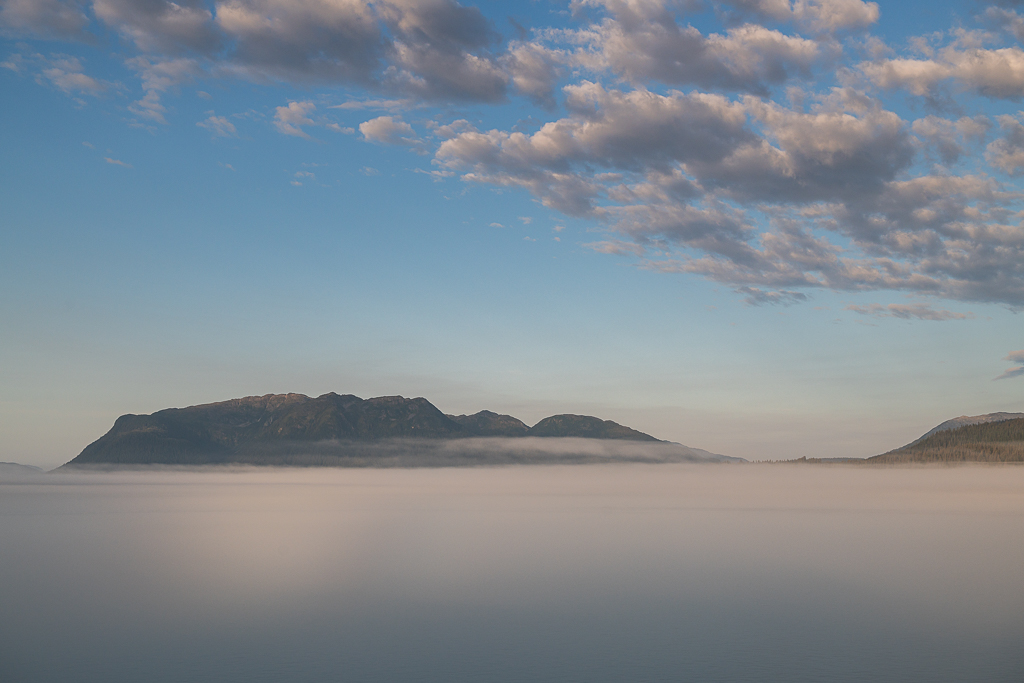


Seeing Glacier Bay again was fantastic, though this time the dramatic effects of global warming could easily be seen.
Rising summer temperatures have contributed to the rapid decline of a number of storied glaciers. Climate scientists have warned that Alaska’s glaciers are uniquely vulnerable to the warmer summer seasons and are losing ice mass at an increasingly fast pace.
Nonetheless, we watched skyscraper-high glaciers calving huge chunks of ice into the water below. And even saw a grizzly bear swimming across the open water, struggling against the ship’s wake.
We also spent time in Skagway, Juneau and Ketchikan. One of the highlights was a visit by small boat to Tracy Arm Inlet just outside Juneau.
The Inlet is really beautiful, with steep valley walls, waterfalls, icebergs, and wildlife. The highlight for us was the Sawyer Glacier itself. Some of the ice is amazingly deep blue. The captain navigated through numerous chunks of ice to get within a few hundred feet of the glacier.
It was raining again by the time we got down to Ketchikan, but we had a fabulous afternoon exploring.
The most striking sight in Ketchikan is its totem poles – some of them still painted in rich, contrasting colours, while others have surrendered some of that colour to the weather.
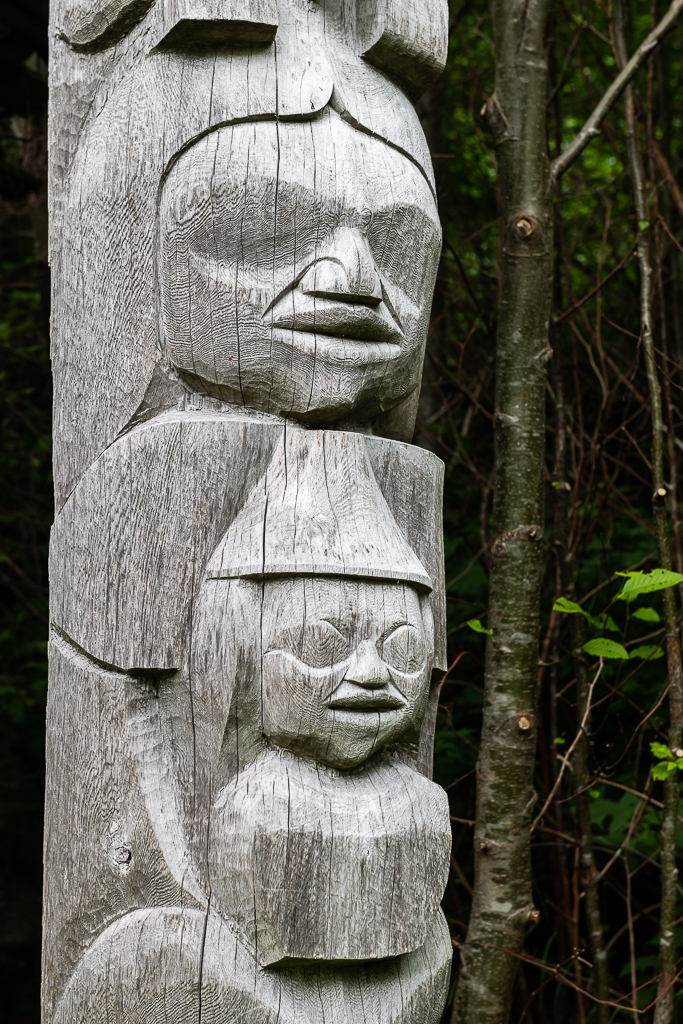



There are more than a dozen of these totems of traditional Tlingit, Haida, and Tsimshian culture standing sentinel all over the city of Ketchikan, but you’ll find them particularly concentrated in Totem Bight State Park. This open-air park also contains a beautiful traditional clan house.
The final day was spent cruising in the Inside Passage….perhaps for the last time.
It brought back memories of another Robert Service poem, my wife first read to us years earlier on the shores of Kluane Lake.
There are strange things done in the midnight sun,
By the men who moil for gold;
The Arctic trails have their secret tales
That would make your blood run cold;The Northern Lights have seen queer sights, But the queerest they ever did see
Was that night on the marge of Lake Lebarge I cremated Sam McGee.

